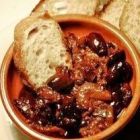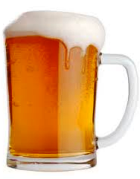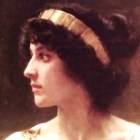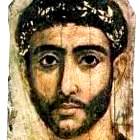Cooking in the ancient world
- In Old
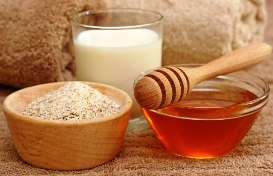 Testament days there were no kitchens. Food was cooked in the open in front of the tent, in the closed courtyards of houses in the cities or in the communal living room.
Testament days there were no kitchens. Food was cooked in the open in front of the tent, in the closed courtyards of houses in the cities or in the communal living room. - Meals might be prepared by either men or women (Genesis 18:7, 8) and it appears that the sexes ate together (Deuteronomy 16:14; 1 Samuel 1:4; Job 1:4; Ruth 2:14).
- Professional cooks called tabbahim and tabbalfioth are mentioned in 1 Samuel 8:13; 9:23, but only rich people could afford them.
What did they eat?
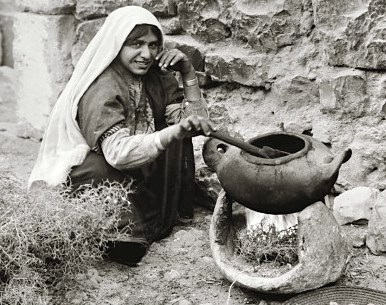
Middle Eastern woman cooking in a courtyard
The cooking of meat is referred to repeatedly, but there are only a few references to cooking vegetables (Genesis 25:29; II Kings 4:38-39).
ln general, meat was either
- boiled in a stew in an earthenware pot (Jud. 6:19 ff; Ezekiel 24:3-5) or
- roasted over an open fire (Exodus 12:9).
Did they use spices?
Among the modern Samaritans, the Passover lamb continues to be prepared in the ancient way, roasted on a spit over hot embers in an earth oven, with a pomegranate branch laid across its mouth.
Meat was also frequently salted to preserve it (Leviticus 2:13). Various condiments and spices, familiar throughout the ancient Near East, were eaten with the meat.
Bread & pancakes
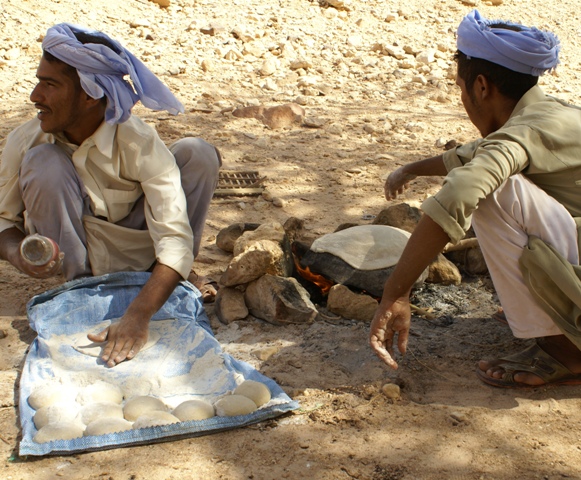
Bedouin men cook flatbread on a hot stone over an open fire
Pancakes made of a sour dough and filled with a tasty mixture were fried in oil (11 Samuel 13:8) or baked on hot stones pulled out of the embers of a fire (1 Kings 19:6).
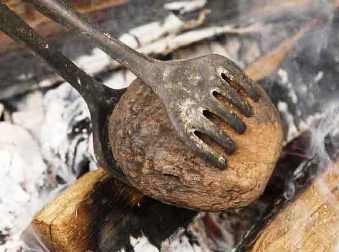
Excavators have found many baking pans on which the dough of bread and cakes was laid and cooked.
Hot stones for cooking on an open fire
When Gideon wished to honour his angelic messenger (see What are angels?) (Jud. 6:19), he prepared a meal of
- unleavened cakes made of flour,
- boiled meat which he put in a basket (sãl), and
- broth in a pot (parûr) which was usually small and of earthenware.
Fish – fresh or dried
Fish would be roasted on a charcoal fire, generally using a wooden or iron spit, although the fish eaten by the disciples of Jesus was cooked directly on the charcoal.
According to the Mishnah, eggs were boiled in the shell or fried in olive oil in a saucepan.
Porridge
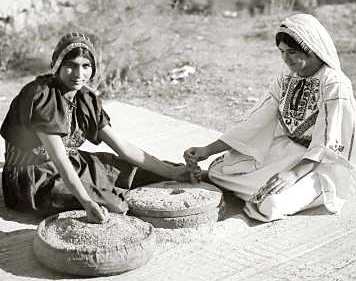
Women hand-milling grain
Cereals like wheat and barley were roasted on an iron plate or in a pan (see image of cooking utensils below) to make the parched corn, or they might be boiled in a pot to make a coarse porridge.
Vegetables were sometimes added to the grain to make a stew which might include rendered butter.
Olive oil was used in place of fat. With this, vegetables, fish and eggs were cooked.
Baking
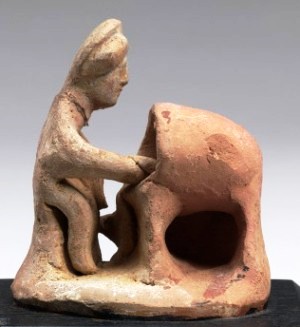
Ancient statuette: woman placing loaves of bread in an oven
The cakes the widow of Zarephath made for Elijah with a handful of meal (l Kings 17:13) were baked on hot stones and covered with hot embers. Thin wafers of dough spread with oil (Exodus 29:2), sometimes strewn with seeds, were baked in an earthenware oven.
Sometimes cakes would be baked with honey (Ezekiel 16:13, 19) and these tasted so good that the manna of the desert was compared to them (Exodus 16:31; Numbers 11:8). The dough was kneaded in a stone mortar as this model shows or it would be rolled as in this 5th century Greek model (right).
Cooking Utensils
lron utensils used in baking and cooking were the griddle or baking pan, which was a shallow iron plate, and the frying pan (Leviticus 2:5-7; Ezekiel 4:30) at right.
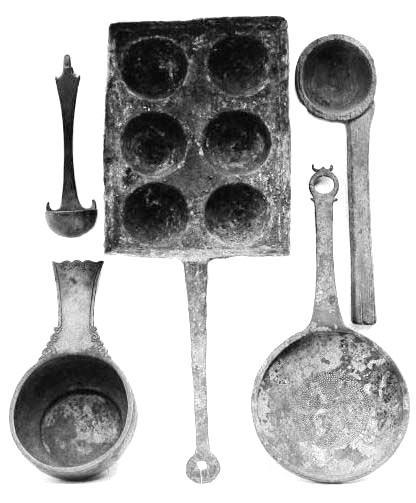 Ordinary cooking dishes and pots were at first of baked, unglazed clay, while ritual vessels and a few special dishes were of copper.
Ordinary cooking dishes and pots were at first of baked, unglazed clay, while ritual vessels and a few special dishes were of copper.
The different types mentioned and found by excavators include the sîr or pot, evidently a large sized pot made of bronze (I Kings 7:40; Ezekiel 24:3); similar to this were the ‘fleshpot’ (Exodus 16:3); the kiyôr or shallow pan; the dûd or kettle; qallahat or cauldron; I Samuel 2:14).
In post-Exilic times, ordinary pottery vessels were replaced in wealthy houses by glazed ‘vessels of the service’ (so-called by the Mishnah) or metal dishes, sometimes even of silver or gold as illustrated by contemporary Roman ware.
Knives to cut meat were at first made of flint (Joshua 5:2), later of bronze.
Forks were not used, apart from a single large one for lifting the pieces of meat out of the pot, a three-pronged fork; I Samuel 2:13). Ladles (see above) were common.
Hearths
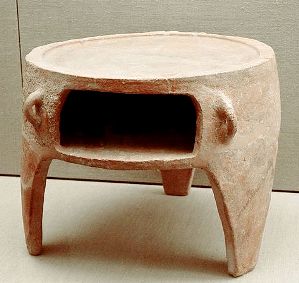
17th century BC portable oven
from Greece
Cooking was done on an open hearth, partially built up with stones as a protection against the wind. Most houses excavated have a depression in the floor, either in the centre or in a corner, bearing clear traces of fire. Obviously, this was the family hearth (lsaiah 30:14).
Sometimes more elaborate hearths were built (Leviticus 11:35). ln Mesopotamia, cooking hearths like these were found dating back to the 3rd and 2nd millenium BC. Round hearths of unfired clay, strengthened with broken pottery, about 70 cm. in diameter, have been unearthed in numerous Israelite and Judean excavations.
The oven used to bake bread and other things was a portable jar or receptacle of terra cotta, which could be heated over a fire.
Meals

Bread and olives,
the morning meal
- The first meal of the day did not call for any cooking and was simply a ‘morning morsel’ in the words of the Talmud, consisting of bread and olives, with an onion or any other fruit or vegetable which might be in season. A heavy breakfast was a matter for reproach (Ecclesiastes 10:16).
- The midday meal would be eaten at noon in the fields or at home, and would consist of bread soaked in wine with a handful of parched corn, a ‘pottage of bread broken into a bowl’, or bread and grilled fish (John 21:9, 13).
- The main meal of the day was eaten in the evening, according to the Bible and Josephus, usually a little before and after sunset, before it became pitch dark. This is the supper time of Luke 14:17, 17:7-8.
Furniture
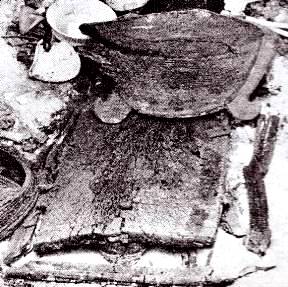
Excavated at Jericho, these wooden boards once formed a table-top
In the early days, people sat on the ground to eat, on cushions, mats of straw or rugs.
In post-Exilic homes, according to the Mishnah, food was served on low ’round, square or oblong’ wooden tables with the participants sitting around on couches or divans, similar to those of the Egyptians – see the excavated wooden boards at right.
In wealthy homes, each honoured guest would be served at a separate table.
Search Box
![]()
Cooking links
© Copyright 2006
Elizabeth Fletcher


